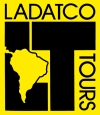

Destinations
Experiences
 |
LADATCO
TOURS |
 |
||||||||
| HOME | South America | Falkland Islands | Antarctica | Unique Destinations |
Unique Experiences |
Newsstand | ||||
 |
The
Andes 5000 miles of travel experiences
|
The Andes span more than 5,000 miles from north to south, traveling along the western side of South America from Colombia to Tierra del Fuego. It is the longest mountain range in the world and with many snow-capped peaks over 22,000 feet it is also the loftiest mountain range in the world. It claims many notables, including Aconcagua (22,835) in Chile, the highest mountain in the Western Hemisphere.
All in all during its 5,000 mile journey, the Andes pass through seven South American countries - Argentina, Chile, Bolivia, Peru, Ecuador, Colombia and Venezuela - and offer a myriad of travel experiences.
From the north two spurs come together, from Venezuela and the Pacific coast meeting in Colombia to begin their journey southbound. In Venezuela, within view of Merida are impressive multiple peaks: Pico Espejo (14,295 ft), Pico Bolivar (15,021 ft), Toro (14,265 ft) Leon (14,220 ft), Humboldt (14,826 ft) and Bompland (14,646 ft).
Reaching Ecuador, the range spreads forming many rich valleys, and the cones of 30 volcanoes provide another magnificent vista. Most are extinct, including Chimborazo, the highest (18,930 ft), Cayambe (17,370 ft), and Illiniza standing directly on the equator (15,789 ft) among others but at least eight are still active, including Cotopaxi (17,691 ft), Tungurahua (15,183 ft, Pichincha (14,382 ft) and Sangay (15,690 ft), one of the world's most active, continuously emitting fumes and ash. Otavalo to the north of Quito and the Avenue of the Volcanoes to the south bask in the beauty of the Andes.
In Peru and Bolivia the Central Andes broaden into multiple ranges over 400 miles wide. Here is the great altiplano and the highest navigable lake on earth, Lake Titicaca, shared by Peru and Bolivia.
Here in the Central Andes, many advanced civilizations developed and the Incas formed their great empire by conquering and dominating these civilizations. The Incas controlled their empire from the heart of the Andes, Cuzco, one of the great cities on earth. A destination in itself, Cuzco is also the gateway to the famed Sacred Valley of the Incas, to the rainforests of Manu and Tambopata and to Lake Titicaca, birthplace of the Inca.
Bordering Peru and sharing Lake Titicaca, Bolivia straddles the Andes, which make up 10% of the country. To the east of the Lake are six peaks soaring above 18,000 feet. The beautiful five-peaked Illimani (19,317 ft) provides a majestic backdrop to La Paz and the Condoriri, a group of 13 mountains ranging from 15,300 ft to 17,100 ft, is a favored climbing destination. Silver extraction from Cerro Rico (14,472 ft) made Potosi one of the biggest cities in the Americas in the mid-1500's and between 1570 and 1650, provided more than half the silver produced in all of the Americas, said to be enough to page a road in silver all the way to Spain.
Continuing south, sub-Andean ranges enclose the high, cold Atacama Desert. Here volcanic Parinacota soars to 18,990 ft, Llullaillaco to 20,217ft and Ojos del Saldo to 20,724 ft.
Hugging the coast of long thin Chile, the Andes and its associated coastal range take up nearly a third of the width of the country, providing many fertile valleys as they cascade southwards. They are once again a majestic backdrop for the capital city Santiago with peaks of 18,000 ft in view most of the year. Just two hours outside of Santiago, Portillo and Valle Nevado ski resorts offer some of the best skiing available and just to the northeast of Santiago, just across the border into Argentina is the highest peak in the Western Hemisphere, Aconcagua at 22,835 ft.
As the Andes plunge south they carve out the spectacular inland fjords and feed many glacier fed lakes and old growth forest in both Chile and Argentina, and reach a true crescendo with Fitz Roy (Parque Nacional Los Glaciares, Argentina) and the Torres del Paine (Paine Towers National Park) stunning exclamation points on the Patagonian steppes. Turning east-west at the tip, the Falkland Islands are a continuation of the Andes and evidence shows that the system is continued in Antarctica as well.